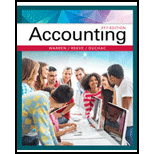
1.
Bonds: Bonds are long-term promissory notes that are represented by a company while borrowing money from investors to raise fund for financing the operations.
Common stock: It refers to a security issued in a form of certificate and implies the right of ownership of an investor over a portion of company’s earnings and assets.
Earnings per Share: It is a portion of profit that is earned by each common stock.
Formula:
To Determine: Earnings per share of common stock for each plan, if income before bond interest and income tax is $2,100,000.
1.
Explanation of Solution
Determine Earnings per share of common stock.
| Particulars | Plan 1 | Plan 2 | Plan 3 |
| Net income before interest on bonds and income tax | $2,100,000 | $2,100,000 | $2,100,000 |
| Less: Interest on bonds | - | - | $720,000(1) |
| Income before income tax | $2,100,000 | $2,100,000 | $1,380,000 |
| Less: Income tax expense | $840,000(2) | $840,000(2) | $552,000(3) |
| Net income | $1,260,000 | $1,260,000 | $828,000 |
|
Dividends on | - | $360,000(4) | $180,000(5) |
| Available for dividends on common stock | $1,260,000 | $900,000 | $648,000 |
| Number of common stock outstanding |
|
|
|
| Earnings per share of common stock | $0.70 | $1.00 | $1.44 |
Table (1)
Working notes:
Calculate interest on bonds for plan 3.
Calculate income tax expense for plan 1 and plan 2.
Calculate income tax expense for plan 3.
Calculate dividends on preferred stock for plan 2.
Calculate dividends on preferred stock for plan 3.
Calculate Number of common stock outstanding for Plan 1.
Calculate Number of common stock outstanding for Plan 2.
Calculate Number of common stock outstanding for Plan 3.
2.
Earnings per share of common stock for each plan, if income before bond interest and income tax is $1,050,000.
2.
Explanation of Solution
Determine Earnings per share of common stock.
| Particulars | Plan 1 | Plan 2 | Plan 3 |
| Net income before interest on bonds and income tax | $1,050,000 | $1,050,000 | $1,050,000 |
| Less: Interest on bonds | - | - | $720,000(1) |
| Income before income tax | $1,050,000 | $1,050,000 | $330,000 |
| Less: Income tax expense | $420,000(9) | $420,000(9) | $132,000(10) |
| Net income | $630,000 | $630,000 | $198,000 |
| Dividends on preferred stock | - | $360,000(4) | $180,000(5) |
| Available for dividends on common stock | $630,000 | $270,000 | $18,000 |
| Number of common stock outstanding |
|
|
|
| Earnings per share of common stock | $0.35 | $0.30 | $0.04 |
Table (2)
Working notes:
Calculate income tax expense for plan 1 and plan 2.
Calculate income tax expense for plan 3.
3.
To describe: The advantages and disadvantages of each plans.
3.
Explanation of Solution
The following are the advantages and disadvantages of Plan 1:
Advantages:
- It involves only in the issuance of common stock. Hence, it does not require to pay periodic interest payment, return on principal, and payment of preferred dividends.
- In case, when earnings before interest and income tax is $1,050,000, Plan 1 is more attractive to common shareholders than Plan 2 and Plan 3 because it has largest EPS ($0.35).
Disadvantage:
- In case, when earnings before interest and income tax is $2,100,000, Plan 1 is less attractive to common shareholders than Plan 2 and Plan 3 because it offers the lowest EPS ($0.70).
The following is the advantages and disadvantages of Plan 2:
Advantage:
- It involves only in the issuance of common stock and preferred stock. Hence, it does not require to pay periodic interest payment, return on principal.
- In both cases, when earnings before interest and income tax is $2,100,000 and $1,050,000, Plan 2 is moderate attractive to common shareholders than Plan 1 and Plan 3 because it provides medium EPS ($1.00) and ($0.30).
Disadvantage:
- In plan 2, it required to pay preferred dividends before common dividends.
The following is the advantages and disadvantages of Plan 3:
Advantage:
- In case, when earnings before interest and income tax is $2,100,000, Plan 3 is more attractive to common shareholders than Plan 1 and Plan 2 because it offers the largest EPS ($1.44).
Disadvantages:
- In case, when earnings before interest and income tax is $1,050,000, Plan 3 is less attractive to common shareholders than Plan 1 and Plan 2 because it provides lowest EPS ($0.04).
- It involves in the issuance of bonds, common stock and preferred stock. Hence, it is required to pay periodic interest payment, principal payment, and also required to pay preferred dividends before common dividends
Want to see more full solutions like this?
Chapter 14 Solutions
Bundle: Accounting, 27th + Cengagenowv2, 2 Terms Printed Access Card

 AccountingAccountingISBN:9781337272094Author:WARREN, Carl S., Reeve, James M., Duchac, Jonathan E.Publisher:Cengage Learning,
AccountingAccountingISBN:9781337272094Author:WARREN, Carl S., Reeve, James M., Duchac, Jonathan E.Publisher:Cengage Learning, Accounting Information SystemsAccountingISBN:9781337619202Author:Hall, James A.Publisher:Cengage Learning,
Accounting Information SystemsAccountingISBN:9781337619202Author:Hall, James A.Publisher:Cengage Learning, Horngren's Cost Accounting: A Managerial Emphasis...AccountingISBN:9780134475585Author:Srikant M. Datar, Madhav V. RajanPublisher:PEARSON
Horngren's Cost Accounting: A Managerial Emphasis...AccountingISBN:9780134475585Author:Srikant M. Datar, Madhav V. RajanPublisher:PEARSON Intermediate AccountingAccountingISBN:9781259722660Author:J. David Spiceland, Mark W. Nelson, Wayne M ThomasPublisher:McGraw-Hill Education
Intermediate AccountingAccountingISBN:9781259722660Author:J. David Spiceland, Mark W. Nelson, Wayne M ThomasPublisher:McGraw-Hill Education Financial and Managerial AccountingAccountingISBN:9781259726705Author:John J Wild, Ken W. Shaw, Barbara Chiappetta Fundamental Accounting PrinciplesPublisher:McGraw-Hill Education
Financial and Managerial AccountingAccountingISBN:9781259726705Author:John J Wild, Ken W. Shaw, Barbara Chiappetta Fundamental Accounting PrinciplesPublisher:McGraw-Hill Education





